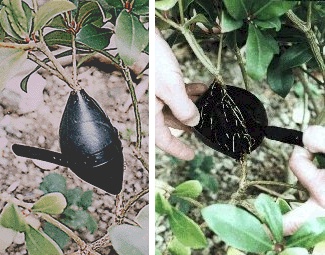 Air Layering
Air Layering Air Layering
Air Layering
General.
Layering is a method of propagating woody plants. It uses the plants natural tendency to produce roots from a branch or twig when it is in contact with the soil. Bramble is a good example of this ability; as a bramble shoot contacts with the soil it takes root and produces new spreading shoots. It is not essential for soil to be present since any damp, dark environment may prove successful.
Traditional Layering.
One traditional method of layering is to bury a low branch in the soil (or within a mound of soil) and secure it by pinning it down with pegs or weights. The process can be enhanced by 'wounding' the branch (by cutting into the bark) prior to burial. Roots can appear within 6 weeks, depending upon species. The use of a rooting compound can increase the chances of success.
The advantages of using the layering technique is that once roots have formed you can sever the branch from its parent, transplant and you have an instant plant genetically identical to its parent.
Air Layering is essentially the same as normal Layering except the propagation takes place in the air! It was apparently first used in China over 4000 years ago and is still practised today. Basically, a cut is made into the branch and the injured section is then encapsulated within peat or moss; it is then wrapped and kept dark. Once rooting begins, the plant is severed from its parent. The advantage of this method is that you can select and layer a greater number of branches and you don't need to bend over to do it.
John Higgins is an expert on layering and has developed a useful device which makes the technique a simple and speedy operation. The device (see photograph above) is available for purchase through his web site which is also packed with useful information detailing the technique of Air Layering.
© 2001 Chris Skellern. AIE. Home | News | A-Z Index | Resources | Contact AIE | Terms of Use